An experimental investigation on static directional stability
Wen Jing,Wang Yankui,Deng Xueying
School of Aeronautic Science and Engineering,Beihang University,Beijing 100083,China
An experimental investigation on static directional stability
Wen Jing,Wang Yankui*,Deng Xueying
School of Aeronautic Science and Engineering,Beihang University,Beijing 100083,China
A generic aircraft usually loses its static directional stability at moderate angle of attack(typically 20–30°).In this research,wind tunnel studies were performed using an aircraft model with moderate swept wing and a conventional vertical tail.The purpose of this study was to investigate flow mechanisms responsible for static directional stability.Measurements offorce,surface pressure and spatial flow field were carried out for angles of attack from 0°to 46°and sideslip angles from-8°to 8°.Results of the wind tunnel experiments show that the vertical tail is the main contributor to static directional stability,while the fuselage is the main contributor to static directional instability of the model.In the sideslip attitude for moderate angles of attack,the fuselage vortex and the wing vortex merged together and changed asymmetrically as angle of attack increased on the windward side and leeward side of the vertical tail.The separated asymmetrical vortex flow around the vertical tail is the main reason for reduction in the static directional stability.Compared with the wing vortices,the fuselage vortices are more concentrated and closer to the vertical tail,so the yawing moment of vertical tail is more unstable than that when the wings are absent.On the other hand,the attached asymmetrical flow over the fuselage in sideslip leads to the static directional instability of the fuselage being exacerbated.It is mainly due to the predominant model contour blockage effect on the windward side flow over the model in sideslip,which is strongly affected by angle of attack.
1.Introduction
In the late 1970s and early 1980s,the tactical advantages of super maneuverability for fighter aircraft increased interest in post-stall maneuverability.1,2Requirement and expectation for the aerodynamic design of moderate to high angle of attack have become higher for modern fighter aircraft.On the other hand,static stability has always been critical and inevitable in the process of modern aircraft design.In the third generation fighter aircraft,static stability was achieved by triaxial design and the operational envelope was kept within a certain essential static stability margin.3With the development of active control technology,it is applied in the third generation of aircraft with relaxed static stability and local static longitudinal instability,but the design for the static lateral-directional stability was generally stable.Su-27 is a typical example of aircraft with local longitudinal static instability,and the lateraldirectionalstability remained within the stable range.Although it is able to perform post-stall maneuverability like a cobra(Su-27 cobra maneuver),the stall was temporary and only lasted for a few seconds.Even when thrust vectoring technology was employed,the aircraft could not maneuver in the post-stall range for a long time due to severe flutter of the aircraft caused by separating flow,which was unbearable forthe pilots.Therefore,the design ofstatic lateraldirectional stability is still stable so far,which is also the case for aircrafts with highly advanced active control technology like F-22.3However,the current study shows that the modern aircrafts,especially aircrafts with conventional layout design following principles of static stability,are prone to problems of lateral and directional nonlinear and insufficient stability at moderate and high angle of attack,which largely limit the maneuverability of the aircraft’s performance,and may endanger the flight safety.4,5
Yawing moment coefficient Cnrepresents the aerodynamic moment coefficients generated about the vertical axis.6The yawing moment coefficient Cnderivatives of the sideslip angle β are called static directional stability derivatives Cnβ.When Cnβ> 0,it indicates that the aircraft is stable,whereas Cnβ< 0 suggests that the aircraft is unstable,and the angle of attack while Cnβ=0 is the critical angle of attack of directional stability.3,4The greater the values of critical angle of attack are,the larger the range of static stability is,and hence the smallest one among the longitudinal,lateral and directional critical angles of attack determine the degree of the available angle of attack for the aircraft.Therefore,the aircraft aerodynamic design should maximize the smallest angle of attack among longitudinal,lateral and directional critical angles of attack in order to increase the available angle of attack range and available flight envelope of the aircraft.However,the directional critical angle of attack of many modern aircrafts is less than the longitudinal and lateral critical angle of attack,which limits the available range of the angle of attack of the aircraft.We take the F-15 as an example7;its stall angle is 35°,while its directional critical angle of attack is approximately 22°.Besides,the angle of attack corresponding to the lift coefficient peak is 35°for F-16,but its directional critical angle of attack is 28.8In conclusion,improvement of the directional critical angle of attack is very important to increase the available range of the angle of attack of modern aircraft.
A number of techniques used to control forebody vortex systems and their associated yawing moments are gradually making the transition from laboratory curiosities to practical applications on highly maneuverable aircraft to increase available flight envelope of the aircraft.9,10In particular,applications of pneumatic vortex control techniques11are being considered for use in the aircraft industry,and it is being done without a complete understanding of the flow field physics responsible for the formation of vortex asymmetry.The issues raised by developing new aircraft can often be used to focus research goals at the fundamental level.When the basic understanding is lacking and models are not available for guidance,the design engineer is forced to rely on extrapolations of empirical measurements and the ‘cut and try” approach.1,10The objective of this study was to identify some areas of weakness in directional stability especially the flow field over the conventional aircraft at directional critical angle of attack,so it could establish the foundation for the improvement measures of static directional stability.
In this research,wind tunnel tests on a generic fighter model with high-mounted swept(Λ =47.5°)wings,single conventional vertical tail,ventral fins and horizontal tails were conducted in Beihang University D4 low speed wind tunnel.The main components generating yawing moment were identified through the force tests.Furthermore,the flow field of the main components responsible for the directional stability at moderate angles of attack was investigated by pressure tests and particle image velocimetry(PIV)tests.The corresponding flow mechanism on the static directional instability of the model was then discussed.
2.Experimental methods
2.1.Wind tunnel facility and procedure
Experiments were conducted in D4 low-speed return wind tunnel at Beihang University.The tests were carried out in the open test section which was 1.5 m×1.5 m with the length of 2.5 m and free stream turbulence level at 0.08%.The tests were carried out at velocity offree stream V∞=35 m/s,which corresponded to a Reynolds number Re=1.54×105based on chord length of the wing.The model was sting-mounted on a supporting mechanism which could provide α variation shown in Fig.1.Tests were performed at fixed angles of attack from 0°to 46°,together concurrent with a sideslip range from-8°to 8°.
Side force and yawing moment were acquired with an internally-mounted six-component force balance.The pressure data acquisition system consisting primarily of a DTC Initium and an ESP module with pressure transducer accuracy of 0.1%FS(FS=±1 psi)was used for surface pressure measurements.FlowMap digital particle image velocimetry(DPIV)system was used for measuring sectional spatial velocity and vorticity field.PIV images were obtained by averaging 50 samples with a spatial resolution of about 2.5 mm.Each cross section of afterbody or wing was photographed twice(right side and left side).The PIV tests were limited by equipment of the D4 wind tunnel,and the minimum angle of attack at which the pictures could be taken was 22°.Therefore,the PIV data could be obtained in the studies are all above 22°.

Fig.1 Support system in D4 open-section wind tunnel.
2.2.Model
The model used in this study was a generic aircraft with its configuration shown in Fig.2(a).It consisted of highmounted swept(Λ =47.5°)wing,a single conventional vertical tail,ventral fins and horizontal tails.Every component could be dismounted.Pressure measurements were carried out with 194 pressure taps distributed in 11 stations over the model as shown in Fig.2(b).There were six stations located at the fuselage(x=0.08,0.15,0.25,0.40,0.48,0.82 m),three stations located at the wings(x=0.515,0.60,0.70 m),and the other two stations located at vertical tail(y=0.10,0.16 m).
3.Results and discussion
3.1.Characteristics of directional stability
The basic lateral-directional aerodynamic characteristics are shown in Fig.3.It is found that the model loses its lateral stability Clβat angle of attack above 35°and loses its directional stability Cnβat angle of attack above 25°.
Fig.4 illustrates the variations of yawing moment coeff icient with angle of attack which were derived from the force measurement(solid line)data and CFD data(dashed line)under conditions of β =4°.The CFD work was done as a preparation for model design before the wind tunnel experiments.In the CFD data,as the components of the model are defined by the grid directly,it is possible to export the force and moment coefficient of every component.However,the force and moment coefficient of every component cannot be obtained directly by force measurement,but rather by mounting or dismounting the components.In this figure,the triangle is the yawing moment of the whole model which includes all components.It is noted that the yawing moment is positive(stable)at lower angles of attack,but as the angle of attack increases,the yawing moment drops and becomes negative(unstable)at around 24°.The other lines show the yawing moment of the different components of the model.
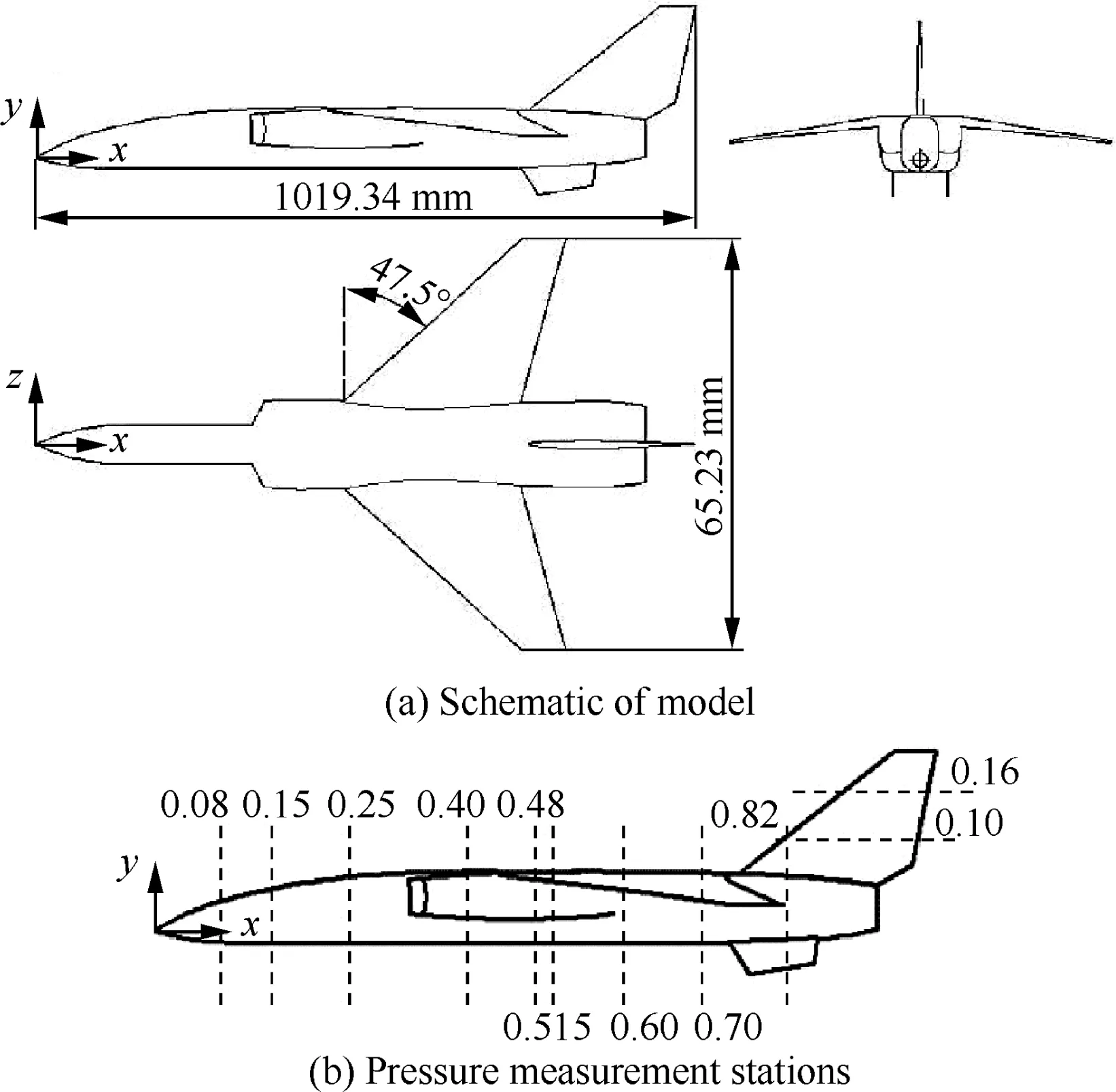
Fig.2 Schematic of model and pressure measurement stations.
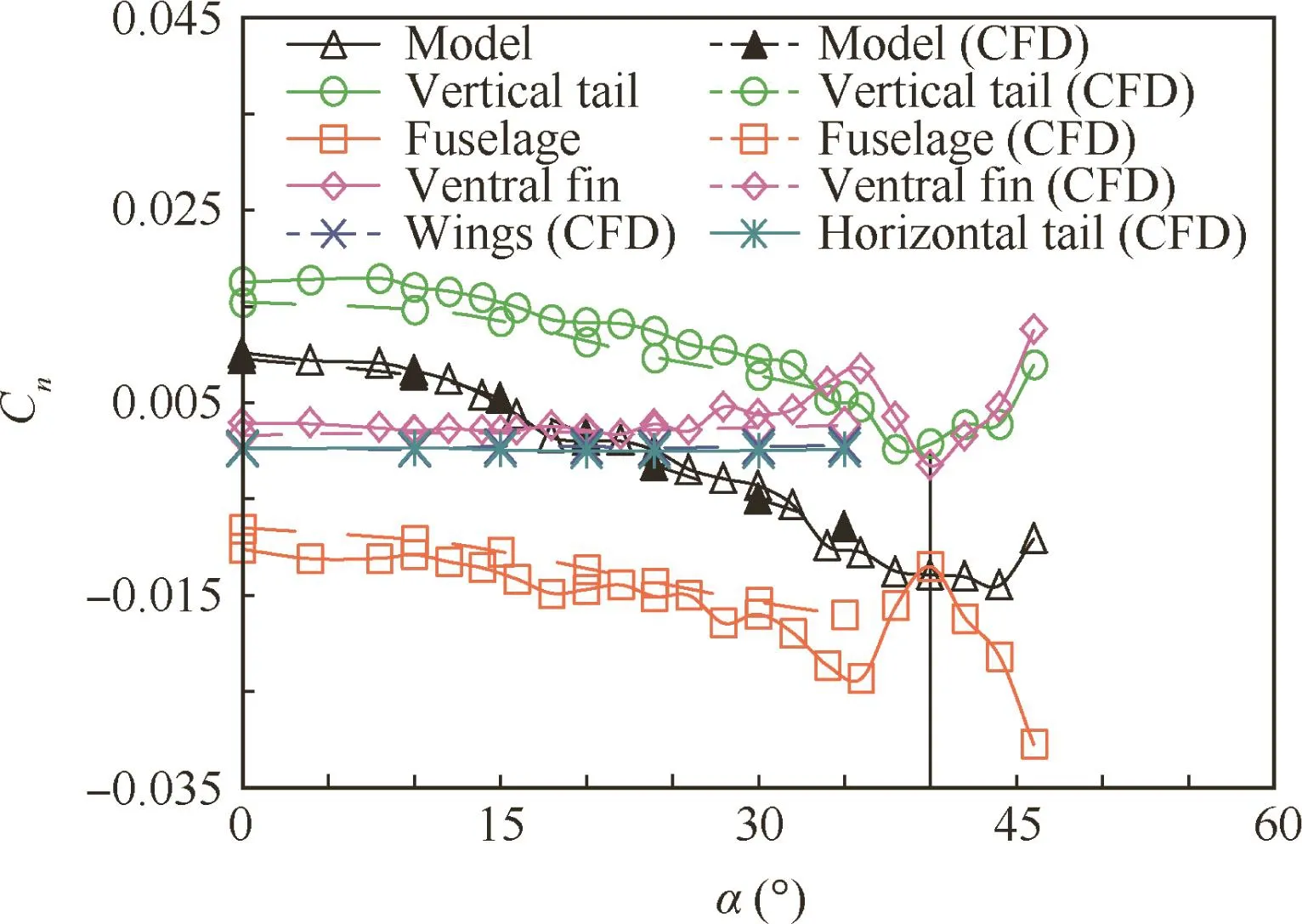
Fig.4 Yawing moment coefficient of model and components,β=4°,Re=1.54× 105.
(1)The yawing moment of ventral fins:CnVF=CnMCnMWVF.CnVFis the yawing moment coefficient of ventral fins;CnMis the yawing moment coefficient of the model;CnMWVFis the yawing moment coefficient of model without the ventral fins.It is apparent that the ventral fins are at the afterbody of the model,and they are the passive components,so the linear formulas can be used to roughly calculate the yawing moment of ventral fins.However,the computational data of the ventral fins are consistent with the experimental data.It is also noticeable that yawing moment of ventral fins remains constant and positive when α ≤ 30°,which implies that the ventral fins are bene ficial for generation of the directional stability of the aircraft and not affected by angle of attack,and thus no modi fication is required to meet the need of ventral fins.
(2)The yawing moment of vertical tail:CnVT=CnMCnMWVT.CnVTis the yawing moment coefficient of vertical tail;CnMWVTis the yawing moment coefficient of the model without the vertical tail.Like the ventral if ns,yawing moment of the vertical tail can be roughly calculated by linear formula.The computational data of the vertical tail are consistent with the experimental data.At zero angle of attack,the vertical tail provides stable yawing moment which remains constant when angle of attack is less than 8°.As angle of attack increases,the stable yawing moment produced by the vertical tail reduces gradually and becomes zero at 38°angle of attack.It means that the effectiveness of the vertical tail decreases quickly with the angle of attack increasing and the vertical tail is one of the main contributors to directional stability.
(3)Theyawing momentoffuselage:CnF=CnMCnVF-CnVT.CnFis the yawing moment coefficient of the fuselage.It is shown that the wings and the horizontal tails do not provide the yawing moment from the computational data,so the yawing moment offuselage can be estimated roughly by subtracting the yawing moment of the ventral fins and the vertical tail from the yawingmoment of the model.The computationalyawing moment of the fuselage is consistent with the experimental data.At zero angle of attack,the fuselage provides unstable yawing moment which increases with angle of attack.Therefore the fuselage is another contributor to directional instability at moderate angle of attack.
Since the vertical tail and the fuselage are the main contributors to directional stability, flow mechanisms of the directional stability can be understood by analyzing the flow field over the vertical tail and the fuselage,which will be discussed in detail later.
3.2.Flow mechanisms for static directional stability of vertical tail

Fig.5 Yawing moment coefficient of vertical tail, β =4°,Re=1.54×105.
Fig.5 shows the yawing moment coefficient of the vertical tail changing with angle of attack at 4°sideslip.Based on the characteristics of the yawing moment provided by the vertical tail in Fig.5,the curve can be divided into two parts.Part I is α ≤ 8°,where the yawing moment generated by vertical tail is constant and stable.The angle of attack has no influence on this yawing moment,which can be confirmed by the pressure distributions over the vertical tail presented in Fig.6(hereinafter the LVTis the length of chord of the vertical tail on the local pressure section,Lxis the x location of the pressure tap on this pressure station,Cpis the pressure coefficient and V∞is the free steam velocity).It is noted that the pressure on the leeward(L)side of vertical tail is negative and that on the windward(W)side is positive at y=0.10 m or 0.16 m pressure station.The negative pressure-p coming from the flow suction effect on the leeward side of the vertical tail provides the aircraft with negative side force-CYand stable yawing moment+Cn,because the center of gravity is located at the front of the vertical.The positive pressure+p coming from the flow pushing effect on the windward side of the vertical tail also provides the aircraft with stable yawing moment(Fig.6(c)).Therefore the area between pressure distribution on the leeward and windward side can be used to represent the effectiveness of the vertical tail,and the bigger this area is,the more directional stability the vertical tail has.
In Part II where α > 8°,the yawing moment of vertical tail decreases as angle of attack increases.Fig.7 shows the pressure distribution of two pressure stations on the vertical tail at 20°,26°and 38°angle of attack respectively.The PIV flow visualization data of the vertical tail at the three angles of attack are presented in Fig.8.Compared with the pressure distributions over the vertical tail at angles of attack less than 8°(Fig.6),the pressure on windward side of the vertical tail in part II becomes negative rapidly,and an adverse effect on the directional stability of aircraft is detected at these angles of attack.At 20°angle of attack,the leeward pressure has a negative growth while the windward pressure decreases from positive to negative values at the same time shown in Fig.7.However,the pressure difference between leeward and windward is negative,which means the yawing moment of the vertical tail is positive(stable)at 20°angle of attack(Fig.7(c)).At this angle of attack,the vortices are tightly rolled up and concentrated emerging at both the leeward and windward(Fig.8(a)).When angle of attack increases to 26°,both the leeward and windward pressures increase negatively,but the negative increment of the windward is more than that of the leeward,which leads to reducing pressure difference between leeward and windward.The stable yawing moment at 26°angle of attack is smaller than that at 20°angle of attack.The vortices at two sides seem looser and less concentrated(Fig.8(b)),and the windward vortex is closer to the vertical tail than the leeward vortex.When angle of attack increases to 38°,the negative pressure value of the windward exceeds than that of the leeward,which results in positive pressure difference between leeward and windward,and the yawing moment of vertical tail reaches zero or even negative values(unstable).It is obvious that the decreasing directional stability of aircraft is solely caused by this flow suction effect on the windward side of the vertical tail at moderate or high attack angle.Alternatively,at lower angle of attack(less than 8°),the sideslip effects,including both pushing effect(positive pressure)on the windward side and suction effect(negative pressure)on the leeward side of the vertical tail,mainly come from the potential attached flow near the vertical tail.At higher angle of attack(for example,20°angle of attack or higher),the sideslip effect on pressure distribution over the vertical tail comes from the combined flow of separated vortex flow from the front part of model and potential attached flow near the vertical tail.With increasing angle of attack,the separated vortex flow effect becomes more evident and the effect of potential attached flow decreases gradually.As a result,the suction effect(negative pressure)on the windward side of vertical tail is stronger than that on the leeward side when the separated vortex flow effect is more evident at higher angle of attack.
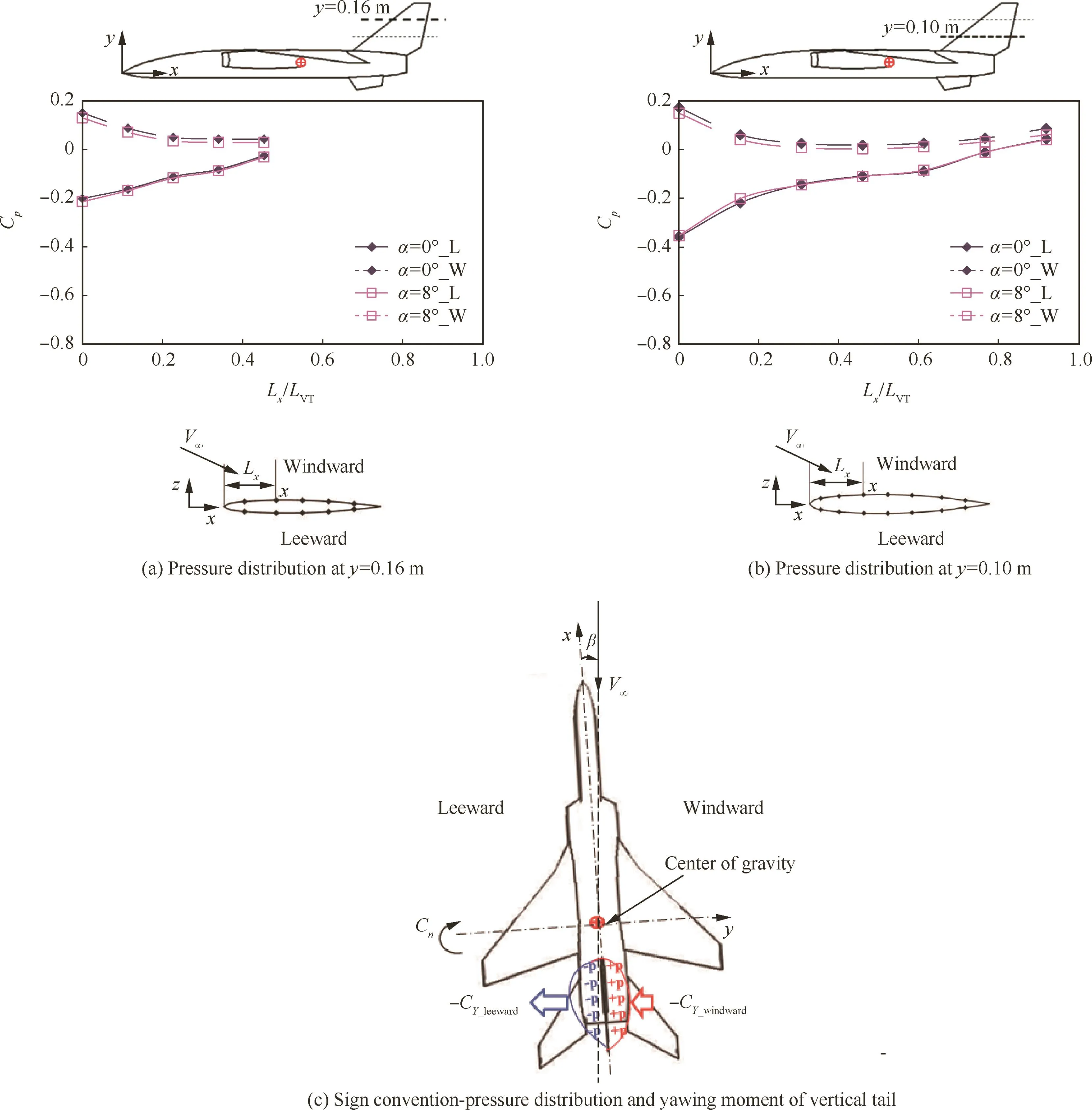
Fig.6 Pressure distribution over vertical tail at different angles of attack in Part I(β =4°,α ≤ 8°,Re=1.54 × 105).
As discussed before,there are two types offlow effects known as separated vortex flow and potential attached flow near the vertical tail in the sideslip attitude.The different influences offlow mechanism on the vertical tail are recognized as the reason for the reducing stable yawing moment provided by vertical tail.In the sideslip attitude,the potential attached flow effect near the vertical tail is straightforward and it is similar to the angle of attack effect for the aircraft model.However,separated vortex flow around the vertical tail including its origin and composition has not been studied thoroughly,which is critical and essential for directional stability.
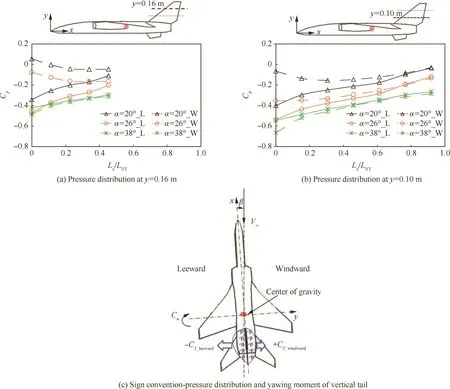
Fig.7 Pressure distribution over vertical tail at different angles of attack in Part II(β =4°,α > 8°,Re=1.54 × 105).
Fig.9 demonstrates the PIV flow visualization of the model at α =26°.This is used as an example to illustrate the formation and breakdown of the vortices around the model at β =4°.The model forebody vortices begin to form at station x=0.30 m(Fig.9(b)),and then move straight toward the inlet station x=0.40 m(Fig.9(c))where the inlet vortices form.These two pairs of vortices from the model forebody and the inlet merge into one pair of vortices at station x=0.48 m(Fig.9(d))where the wing leading edge vortices begin to form.At x=0.60 m(Fig.9(f)),all these vortices merge together,then break down,and finally form the combined vortices which cover the vertical tail(Fig.9(h)).Therefore,the flow over the vertical tail is dominated by merged vortices(forebody vortex,inlet vortex and wing vortex)from upstream flow.
From Fig.9,it can be seen that the yawing moment of vertical tail is dominated by merged vortices(forebody vortex,inlet vortex and wing vortex)from upstream flow.However,it is unclear which vortex,i.e.,forebody vortices,inlet vortices or wing vortices,is the primary flow responsible for directional stability from the above test data.If the primary flow is comprehended,the method for improving directional stability can be achieved.
As the wings of the model can be dismounted,the original model with wings is named Model A and the model without wings is named Model B.Fig.10 demonstrates the yawing moment of vertical tail for Model A and Model B.It is apparent that dismounting the wings(Model B)leads to the yawing moment of vertical tail reducing more rapidly,which means that the fuselage flow increases the unstable yawing moment of vertical tail as the angle of attack increases.
Figs.11 and 12 show the flow structure and pressure distribution of the vertical tail for Model A and Model B.When the wings are taken off,the fuselage vortex is still generated and its vorticity keeps almost constant in the region from the upper surface of inlet to the vertical tail as the angle of attack is above 10°.The fuselage vortices are more concentred with lager vorticity and stay closer to the vertical tail,and the range of influence for the vertical tail is smaller than the flow field including wing vortex.The bottom of the vertical tail is greatly influenced by the fuselage vortex,which results in more rapid increase in negative pressure at windward side when the angle of attack rises,while the efficiency of vertical tail is reduced.However,comparing to the condition in which the angle of attack is under 30°(Fig.13(a)),the yawing moment of the vertical tail starts to return due to complete breakdown offuselage vortex at windward side when the angle of attack increases to 32°and above(Fig.13(b)).

Fig.8 Vorticities and streamlines around vertical tail at different angles of attack(PIV test,β=4°,x=0.86 m),Re=1.54× 105.
However,CFD data(limited by the experimental conditions,PIV tests cannot obtain the flow structure pictures below 22°)show that after the wings are fixed,at 10°angle of attack,a vortex forms at the apex of the wing.At 15°angle of attack,the vortex originating from the wing and a portion of the fuselage fluid is drawn into a large vortical structure resident above the wing.The wake flows downstream and passes the vertical tail.At angles of attack of 20°and above,the vortical flow field above the wing has increased in size in both the spanwise and vertical directions and more fluid originating at the fuselage is now drawn spanwise into the vortex.Since the fuselage vortex is involved in the wing vortex which has been broken down at moderate angle of attack and the mixed vortex is away from the vertical tail,the coupled vortex weakens the windward negative pressure which is smaller than that without wings.The yawing moment of vertical tail is more stable than that when the wings are absent.Therefore,the fuselage flow is more detrimental to the vertical tail compared with the wing flow.
3.3.Flow mechanisms for static directional instability offuselage
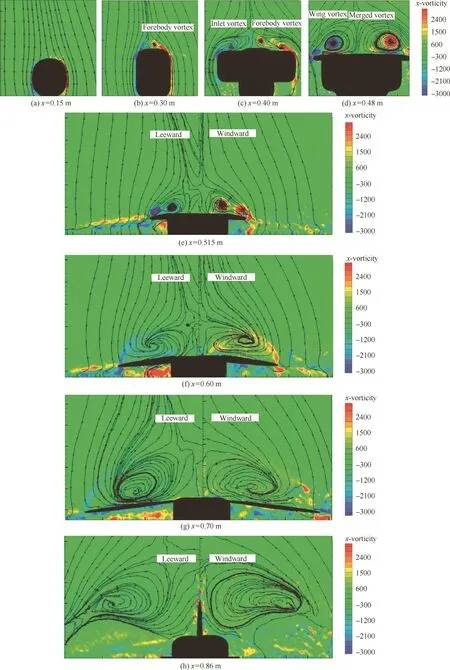
Fig.9 Flow structure at different stations of model(PIV test,α =26°,β =4°),Re=1.54 × 105.

Fig.10 Yawing moment of vertical tail of Model A and Model B,β=4°,Re=1.54×105.

Fig.11 Vorticities and streamlines around vertical tail for Model A and Model B(PIV test, α=26°, β =4°,x=0.86 m),Re=1.54×105.
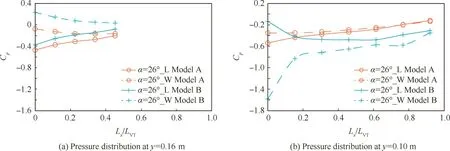
Fig.12 Pressure distribution over vertical tail for Model A and Model B(α =26°,β =4°),Re=1.54 × 105.

Fig.13 Vorticities and streamlines around vertical tail for Model B at different angles of attack(PIV test, β =4°,x=0.86 m),Re=1.54×105.
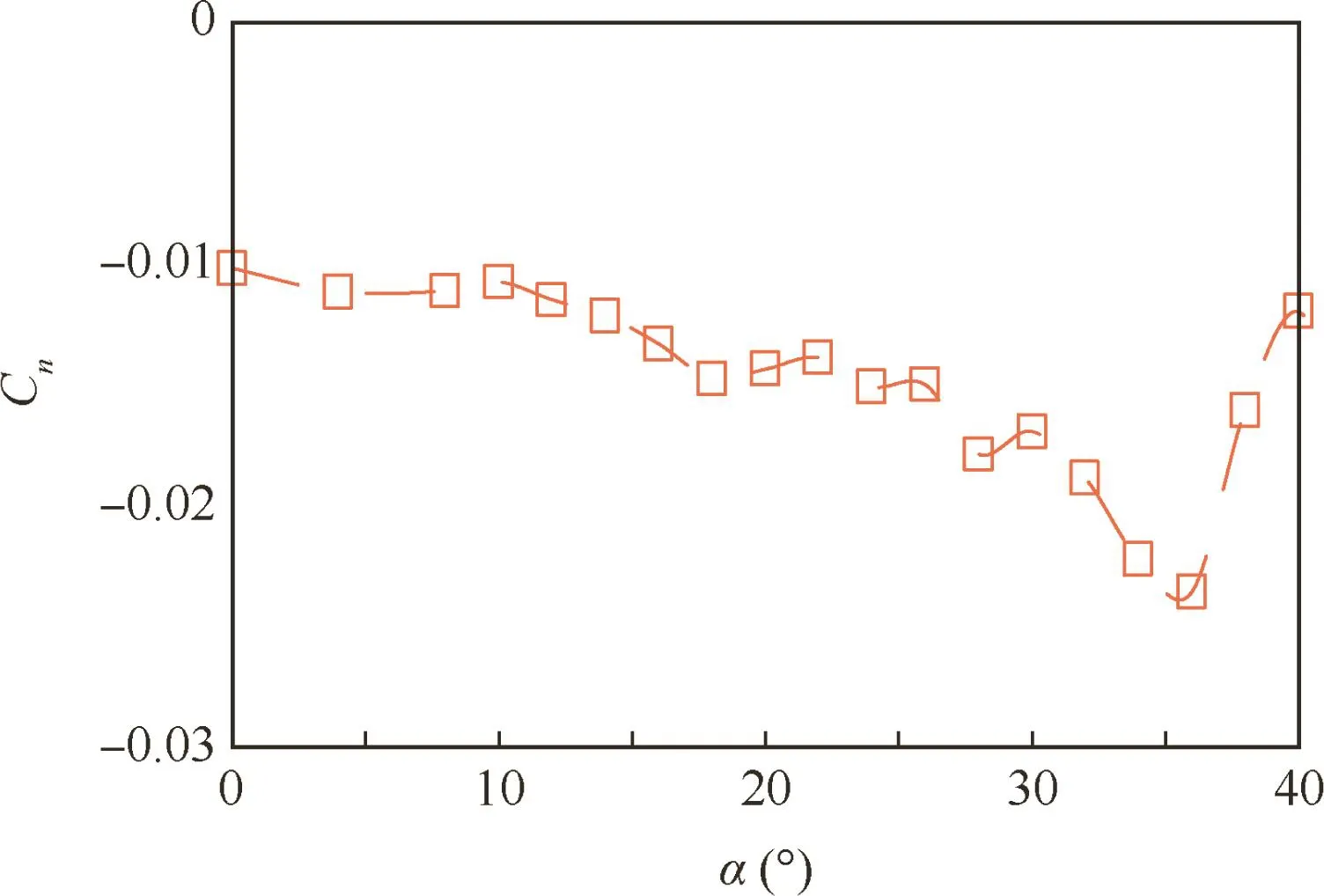
Fig.14 Yawing momentcoefficientoffuselage, β =4°,Re=1.54×105.
Fuselage is another important component for directional instability that produces unstable yawing moment.As shown in Fig.14,when angle of attack increases,the unstable yawing moment provided by fuselage is enhanced.Many researches have indicated that the forebody asymmetric vortices are the sources of large uncontrollable yawing moments at high angle of attack.12–17Nevertheless,the critical angle of attack for directional stability is usually within the range of moderate angles of attack,at which the forebody asymmetric vortices have not formed.18–20Therefore,it is important to investigate the flow field responsible for directional instability offuselage at moderate angle of attack.
The yawing moment Cnand the side force CYderived from integral of pressure distribution at five fuselage stations(Fig.15)changing with angle of attack are shown in Figs.16 and 17 respectively.It can be seen from Fig.16 that when the angle of attack is small,the unstable(negative)yawing moments generated by the front part of the fuselage(including cross sections x=0.08 m and x=0.15 m as shown in Fig.15)are greater than those generated by the middle part of the fuselage(including cross sections x=0.25 m,x=0.40 m and x=0.48 m which are shown in Fig.15).Nevertheless,as the angle of attack increases,the unstable yawing moments of the front part of the fuselage keep constant,but the unstable yawing moments of the middle part of the fuselage increase significantly.When angle of attack is above 20°,the unstable yawing moments provided by the middle parts exceed those of the front.As shown in Fig.17,the side forces of the middle part change with increasing angle of attack,which indicates that the flow over the middle part of the fuselage is largely in fluenced by the angle of attack,thus leading to the increasing unstable yawing moment as the angle of attack increases.PIV figures and pressure distributions of cross section x=0.15 m in the front part,cross section x=0.40 m and x=0.48 m in the middle part of the fuselage are given to analyze flow mechanisms of directional instability generated from the fuselage.
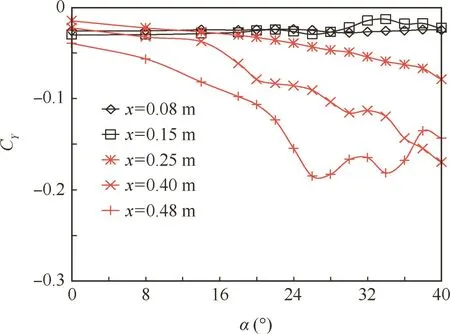
Fig. 17 Side force of fuselage cross-sections, β =4°,Re=1.54×105.
Fig.18 illustrates the flow structure of cross section x=0.15 m at front fuselage by PIV test under conditions of sideslip at 4°and angle of attack at 20°,26°and 32°respectively.Fig.19 gives out the pressure distributions of this section with angle of attack α from 8°to 30°.It can be found from Fig.18 that there is no flow separated phenomena except the potential attached flow near the front fuselage and a little asymmetric flow around the front fuselage due to sideslip effect.It is also noted that,with the angle of attack increasing from 20°to 32°,the vorticity value in the boundary at x=0.15 m becomes larger and the corresponding pressure value at every location on the model surface becomes even larger with increasing angle of attack.
Although the freestream velocity component along the fuselage section is different at various angles of attack and the resulted pressure data on the model surface also vary,the integrated sectional side force at x=0.15 m keeps constant with changing angles of attack,as shown in Fig.20(shown in line x=0.15 m).This section at the front part offuselage thus yields negative side force and unstable yawing moment.For further analysis,the entire section x=0.15 m is separated into four segments(Fig.21).The first segment(S1)covers the bottom of the section;the second segment(S2)covers the leeward side(the left side);the third segment(S3)covers the top of the section;the last segment(S4)covers the windward side(the right side).Similarly,the pressure distribution can be divided into four segments(Fig.19).The variation of side force CYwith angle of attack for each segment can then be calculated by integrating the corresponding pressure distribution(Fig.20).As shown in Fig.20,there is almost no side force yielded from the first and third segments,and hence side force of this section is produced by pressure distributions of S2 and S4.Comparing CYof S2(triangle solid line)with CYof S4(square solid line),we can see that the slope of the CYcurves with angle of attack on the leeward and on the windward has the same absolute value but with inverse signs.Since there is no separated flow,windward flow field and leeward flow field change symmetrically as angle of attack increases at moderate angle of attack despite the presence of asymmetric flow around the front part offuselage in the sideslip attitude.Therefore,the sectional side force CYof x=0.15 m is not affected by angle of attack,which means that the front part of the fuselage has no contribution to the exacerbated directional instability of the aircraft model.
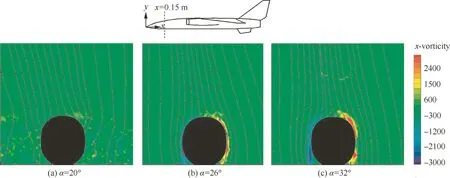
Fig.18 PIV data at different angles of attack for cross-section x=0.15 m,β=4°,Re=1.54× 105.
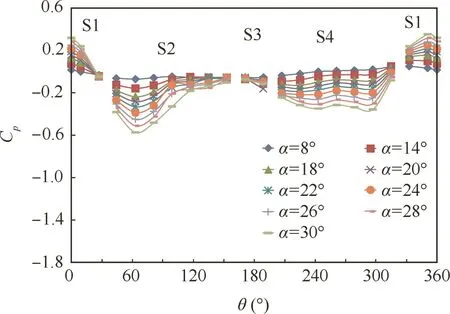
Fig.19 Pressure distribution for cross-section x=0.15 m,β=4°,Re=1.54× 105.
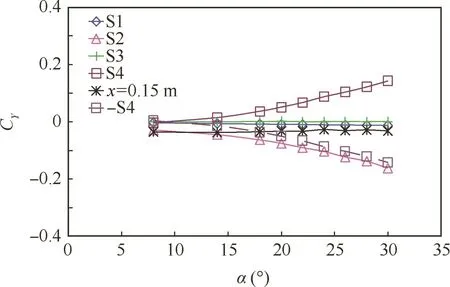
Fig.20 Pressure integral CYof segments for cross-section x=0.15 m,β=4°,Re=1.54× 105.
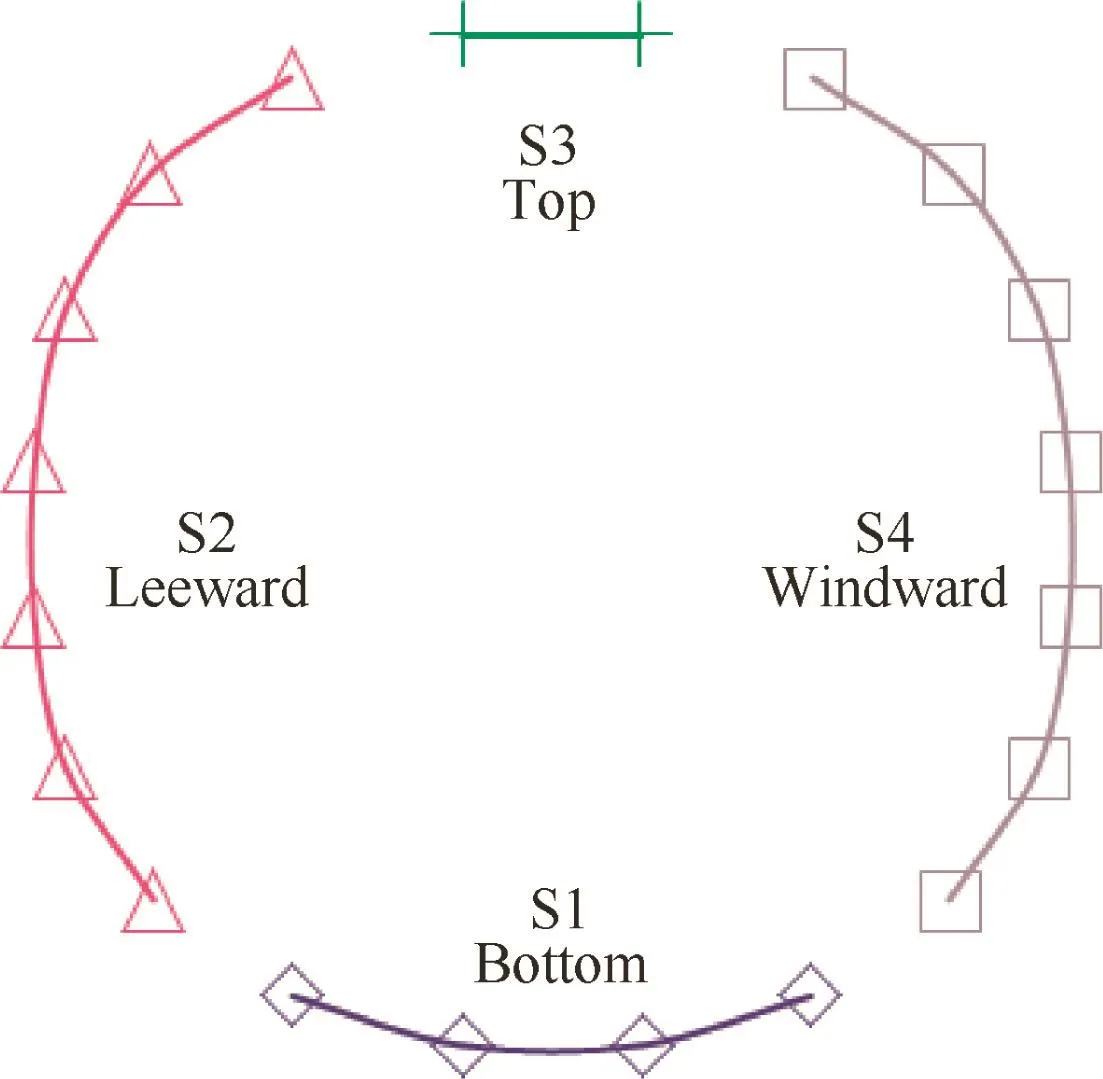
Fig.21 Sketch of segments for cross-section x=0.15 m.
Fig.22 illustrates the flow structure of the cross section x=0.40 m at middle part of model by PIV test when the model attitude was varied with angle of attack at 20°,26°and 32°respectively and sideslip at 4°.
Fig.23 demonstrates the pressure distribution of this section for angle of attack from 8°to 30°.It can be seen from Fig.22 that there is no flow separated phenomena near the bottom(S1 in Fig.24),side S2 or side S4.Nonetheless,separated vortices are detected on the top(S3 in Fig.24),which is also supported by the presence of suction peak in pressure distribution at S3 segment in Fig.23.
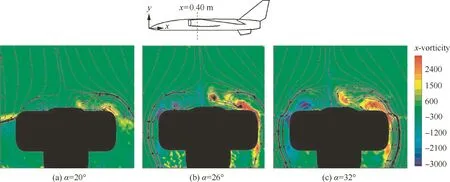
Fig.22 PIV data at different angles of attack for cross-section x=0.40 m,β=4°,Re=1.54× 10.5

Fig.23 Pressure distribution for cross-section x=0.40 m,β =4°,Re=1.54× 105.
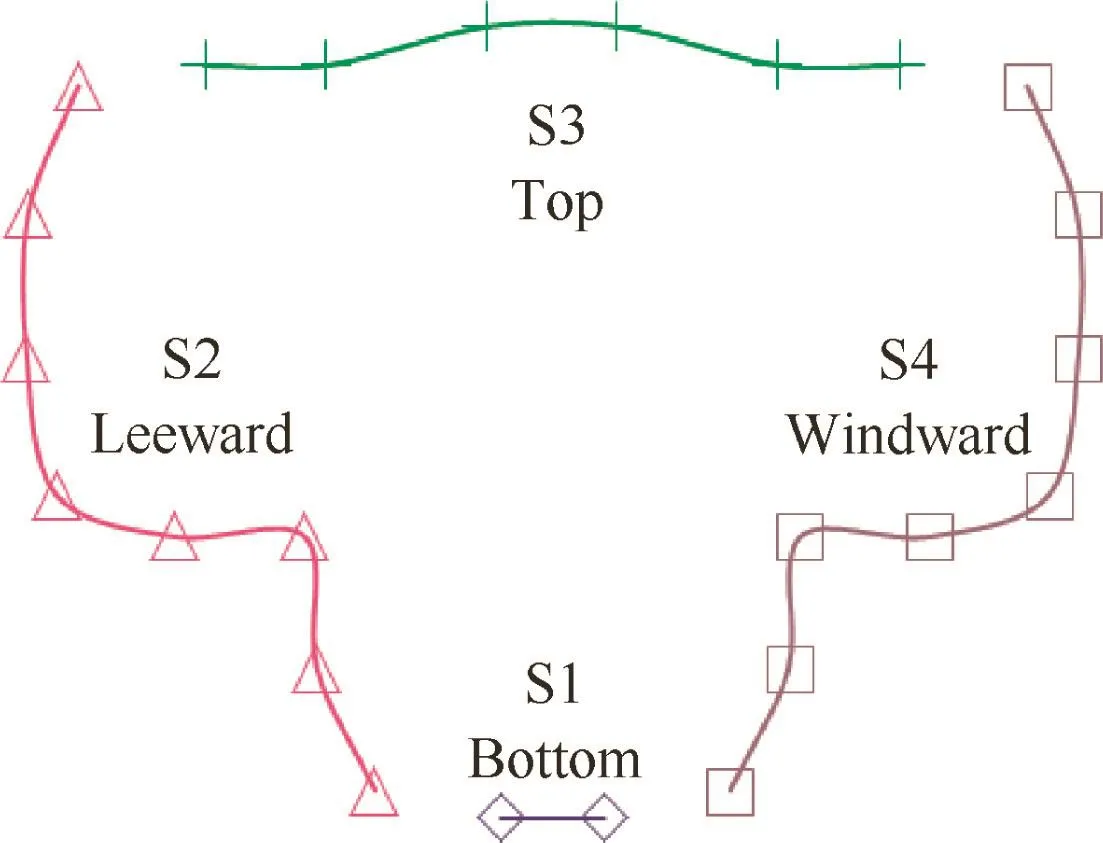
Fig.24 Sketch of segments for cross-section x=0.40 m.
Similar to the method applied to analysis of pressure distribution and side force for section x=0.15 m,the section x=0.40 m is also separated into four segments(Fig.24).The curves of sectional CYwith the angle of attack for each segment can then be calculated through integration of their corresponding pressure distribution(Fig.25).It can be seen from Fig.25 that the side force is yielded neither from the bottom of the section(S1),nor from the top of the section(S3)though there are vortices over it.However,the sectional side forces induced by the pressure distribution on S2 and S4 are significantly different from each other.As the angle of attack increases,the negative side force on leeward side S2 increases more rapidly than the positive side force on the windward side S4 by comparing S2 line and S4 line(or-S4 line).The asymmetric change of side force between leeward side S2 and windward side S4 leads to increase in negative yawing moment,which indicates that the directional instability provided by the middle fuselage intensifies with increasing angle of attack.From Fig.23,it can be found that it is the difference between the corner blockage effect on the flow over the windward side S4 and leeward side S2 that leads to the increase in sectional negative side force.On the windward side S4,the positive pressure near the surface corner between S1 and S4 is greater and its incremental change is also greater than that on the leeward side between S1 and S2 as the result of flow stagnation effect with increasing angle of attack which leads to the slower increase in side force of S4 than that of S2.Therefore,the main reason for the directional instability provided by the middle part of the aircraft model is the potential attached flow near the fuselage.The corner blockage effect on the windward side flow over the model due to contour difference is more serious than that on the leeward one,and is strongly affected by the angle of attack,which exacerbates the directional instability of the aircraft model.The asymmetric fuselage vortices can be seen in Fig.22.With increasing angles of attack,the asymmetric fuselage vortices vary asymmetrically.The leeward vorticity is stronger than the windward vorticity,and the asymmetric fuselage vortex system will influence the potential attached flow around the fuselage.
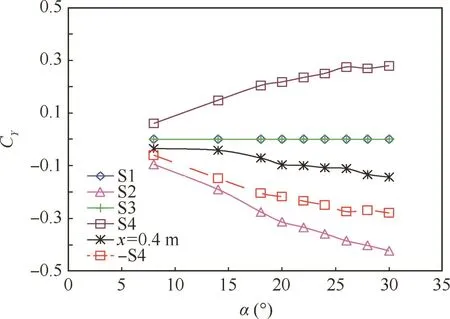
Fig.25 Pressure integral CYof segments for cross-section x=0.40 m,β=4°,Re=1.54×105.
Figs.26–29 show the results of cross section x=0.48 m just behind the tip of the wing,which is hereinafter referred to as middle-wing part of the model and known from the middlepartmentioned before.Similarto theanalysisat x=0.40 m in the previous part,the pressure distributions of the leeward side S2 and windward side S4 are the primary sources of side force and yawing moment provided by cross section x=0.48 m,while the top and bottom sections do not make any contribution.Therefore,the directional instability caused by this part of the aircraft model is also the potential attached flow near windward and leeward side of the fuselage in the sideslip attitude.

Fig.26 PIV data at different angles of attack for cross-section x=0.48 m,β=4°,Re=1.54× 105.
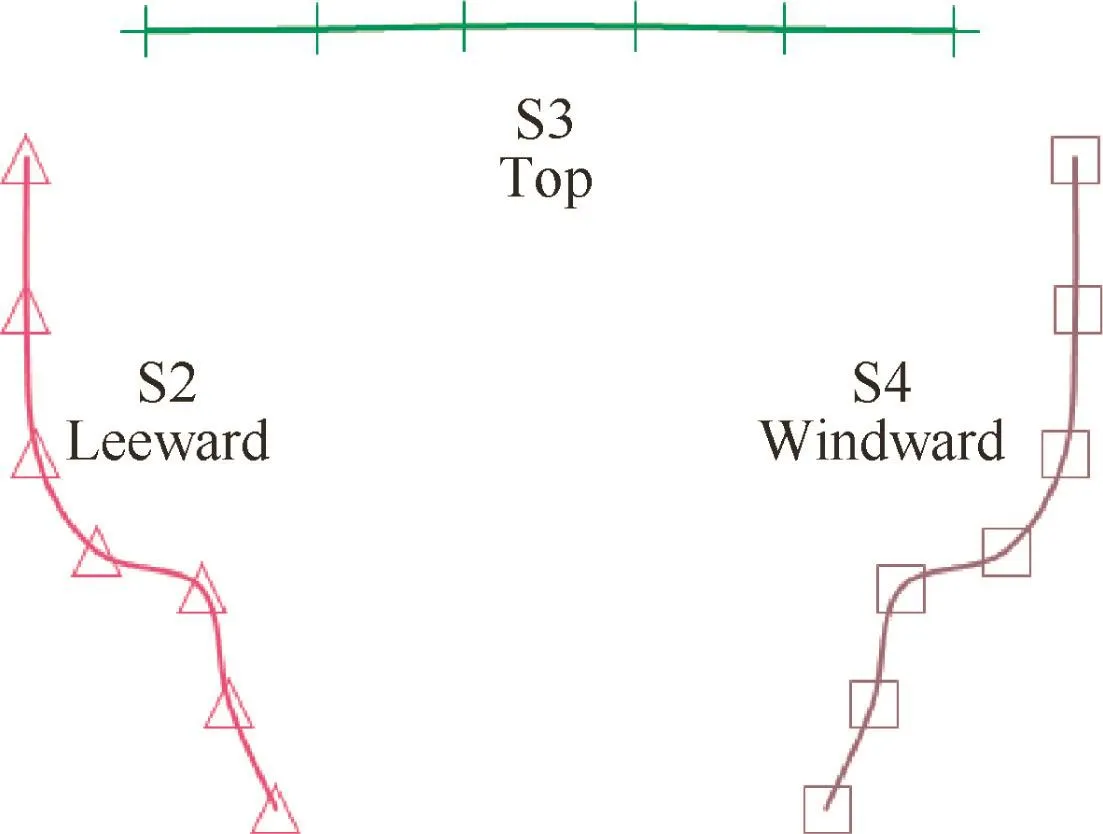
Fig.27 Sketch of segments for cross-section x=0.48 m.
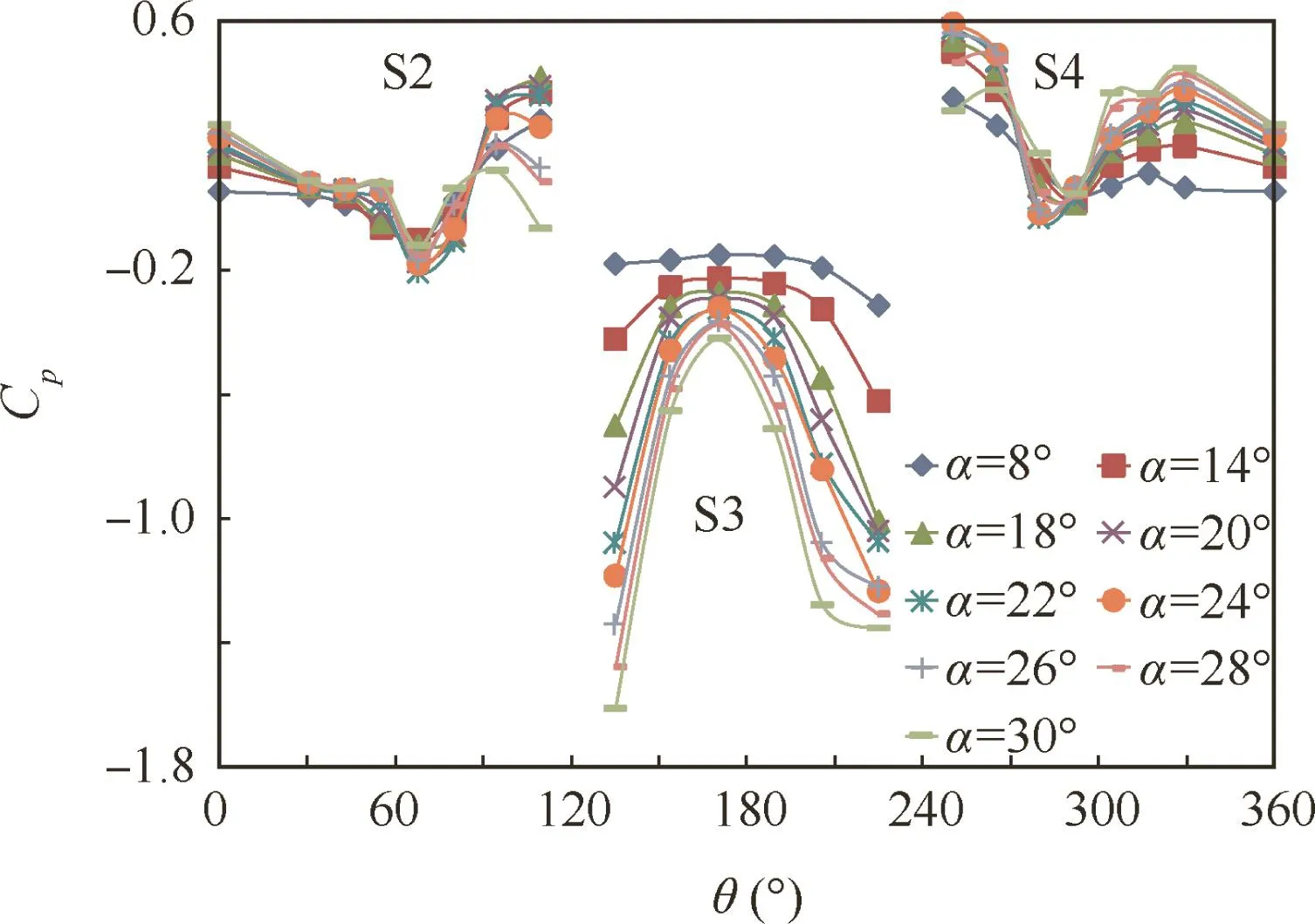
Fig.28 Pressure distribution for cross-section x=0.48 m,β=4°,Re=1.54× 105.
In contrast to the pressure characteristics at section x=0.40 m,i.e.,positive values in the corner and negative values at the side,at the section x=0.48 m,positive pressure is detected at both leeward and windward sides due to the wing blockage effect on the flow over the fuselage.Furthermore,the wing blockage effect on the windward side is predominant over that on the leeward side under sideslip,which leads to the unstable yawing moment.Besides,this wing blockage is affected by angle of attack.Because the asymmetrical wing vortices have been formed at moderate angle of attack in the sideslip attitude,and the vortices vary asymmetrically with angles of attack,the vortex flow would influence the attached potential flow around the fuselage,and hence the attached potential flow also increases asymmetrically with angles of attack.It is obvious that the middle part of the fuselage and the middle-wing part of the model,where the vortices are formed,are the sensitive regions for the unstable yawing moment when angle of attack increases.

Fig.29 Pressure integral CYof segments for cross-section x=0.48 m,β=4°,Re=1.54× 105.
4.Conclusions
Wind tunnel experiments using a generic aircraft model with moderate swept wing and a single vertical tail were conducted in Beihang University D4 wind tunnel to investigate flow mechanism of the directional stability at moderate angle of attack especially the critical angle of attack(about 25°).It is confirmed by force measurement that the vertical tail and the fuselage are the main components for directional stability of the model,and flow mechanisms of the directional stability can be evaluated by analyzing the flow field over the vertical tail and the fuselage.
For vertical tail,at moderate angles of attack,a complexseparated vortex flow merged with the fuselage vortices,inlet vortices and wing vortices together,and it changed asymmetrically in the sideslip attitude.As angle of attack increased,the windward negative pressure value increased more rapidly than the leeward one.Therefore,these complex-separated vortex flows around the vertical tail were the main reason for the loss of directional stability of vertical tail.Compared with the vertical tail in the wake of wing and fuselage,the vertical tail in the wake offuselage flow lost its effectiveness more rapidly as the fuselage vortices became more concentrated and were closer to the vertical tail with larger vorticity.If the vortex at windward side completely broke down,the stable yawing moment of the vertical tail could return.
For fuselage,at moderate angle of attack,the forebody vortex did not form,but the inlet vortex and wing vortex formed.By analyzing Cnand CYderived from the five sectional integrals of the pressure results of the fuselage,it was found that flow field of the middle part offuselage was largely in fluenced by the angle of attack,which contributed to the increasing directional instability as the angle of attack increased.Moreover,the inlet vortex and wing vortex were placed on the middle part offuselage.The attached asymmetrical flow on the windward and leeward side of the fuselage in the sideslip attitude varied asymmetrically.The model contour blockage effect on the windward side flow over the model in sideslip was more greatly affected by the angle of attack.However,the pressures on the two sides were in fluenced by the asymmetrical vortex system.As the vortices were formed asymmetrically,the flow field around the fuselage changed asymmetrically,which led to the increasing unstable yawing moment.
Acknowledgments
The project was supported by the National Natural Science Foundation of China(No.11272035)and the Aeronautical Science Foundation of China(No.2011ZA51003).
1.Williams David R.A review offorebody vortex control scenarios.28th fluid dynamics conference.Snowmass Village(CO):American Institute of Aeronautics and Astronautics;1997.p.1–9.
2.Herbest WB.Supermaneuverability.Proceedings of workshop on unsteady separated flow.1983.p.1–9.
3.Chen B.Investigation of improving the lateral static stability for the aircraft applied to high-subsonic flow and high angle of attack.J Exp Fluid Mech 2005;19(1):109–12[Chinese].
4.Schairer GS.Directional stability and vertical surface stalling.J Aeronaut Sci 1941;8(7):270–5.
5.Hunt BL.Asymmetric vortex forces and wakes on slender bodies.Reston:AIAA;1982,Report No.:AIAA-1982-1336.
6.Hurt Jr HH.Aerodynamics for naval aviators.Washington,DC.:U.S.Government Printing Office;1965,Report No.:NAVAIR 00-80T-80.
7.Lorincz DJ,Friend EL.Water tunnel visualization of the vortex flows off-15.Reston:AIAA;1979,Report No.:AIAA-1979-1649.
8.Sang YS,Tian PY,Wei YS,Luo CP.Analysis of departure/spin characteristics off-16 at high angle of attack.Flight Dynam 2002;20(1):58–62[Chinese].
9.Malcolm GN,Ng TT.Aerodynamic control of aircraft by forebody vortex manipulation.AIAA aerospace engineering conference and show.Reston:AIAA;1990.p.1–22.
10.Malcolm GN. Forebody vortex control- a progress review.Reston:AIAA;1993,Report No.:AIAA-1993-3540.
11.MosbargerNA.Pneumaticaerodynamicdevicedevelopment(PADD):An evaluation,1996,Report No.:WL-TR-96-3101.
12.Degani D,Tobak M.Experimental study of controlled tip disturbanceeffecton flow asymmetry.PhysFluids1992;4(12):2825–32.
13.Shah GH,Granda JN.Application offorebody strakes for directional stability and control of transport aircraft.Reston:AIAA;1998,Report No.:AIAA-1998-4448.
14.Huffman JK,Hahne DE.Experimental investigation of the aerodynamic effects of distributed spanwise blowing on a fighter configuration.Reston:AIAA;1984,Report No.:AIAA-1984-2195.
15.Moskovitz CA,Hall RM,DeJarnette FR.New device for controlling asymmetric flow fields on forebodies at large alpha.J Aircraft 1991;28(7):456–62.
16.Chambers JR,Grafton SB.Aerodynamic characteristies of airplanes at high angle of attack.Washington,DC.:NASA;1971,Report No.:NASA TM 74097.
17.Durston DA,Schreiner JA.High angle of attack aerodynamics of a strake-canard-wing V/STOL fighter configuration.Reston:AIAA;1983,Report No.:AIAA-1983-2510.
18.Deng XY,Wang YK.Asymmetric vortices flow over slender body and its active control at high angle of attack.Acta Mech Sin 2004;20(6):567–79.
19.Chen XR,Deng XY,Wang YK,Liu PQ,Gu ZF.Influence of nose perturbations on behaviors of asymmetric vortices over slender body.Acta Mech Sin 2002;18(6):581–93.
20.Hall RM.Impact offuselage cross section on the stability of a generic fighter. 16th applied aerodynamics conference.Reston:AIAA;1998.p.515–25.
Wen Jing received the B.E.and M.E.degrees in engineering mechanics from Northwestern Polytechnical University in 2005 and 2008 respectively,and is currently pursuing a Ph.D.degree at School of Aeronautic Science and Engineering in Beihang University.Her main research interests are high angle of attack aerodynamics and lateraldirectional static stability.
Wang Yankui is a professor and Ph.D.supervisor at School of Aeronautic Science and Engineering in Beihang University.His current research interests are high angle of attack aerodynamics,vortical and separated flow,dynamic motions of aircraft at fixed angle of attack and in pitch-up.
Deng Xueying is a professor and Ph.D.supervisor at School of Aeronautic Science and Engineering in Beihang University.His current research interests are high angle of attack aerodynamics,vortical and separated flow,dynamic motions of aircraft at fixed angle of attack and in pitch-up.
1 December 2015;revised 23 February 2016;accepted 26 April 2016
Available online 21 October 2016
Asymmetric flow;
Directional stability;
Flow mechanisms;
Sideslip;
Yawing moment
Ⓒ2016 Production and hosting by Elsevier Ltd.on behalf of Chinese Society of Aeronautics and Astronautics.This is an open access article under the CC BY-NC-ND license(http://creativecommons.org/licenses/by-nc-nd/4.0/).
*Corresponding author.
E-mail addresses:wenjing-1983@163.com(J.Wen),wanyankui@buaa.edu.cn(Y.Wang),dengxueying@vip.sina.com(X.Deng).
Peer review under responsibility of Editorial Committee of CJA.
Production and hosting by Elsevier
http://dx.doi.org/10.1016/j.cja.2016.10.008
1000-9361Ⓒ2016 Production and hosting by Elsevier Ltd.on behalf of Chinese Society of Aeronautics and Astronautics.
This is an open access article under the CC BY-NC-ND license(http://creativecommons.org/licenses/by-nc-nd/4.0/).
 CHINESE JOURNAL OF AERONAUTICS2016年6期
CHINESE JOURNAL OF AERONAUTICS2016年6期
- CHINESE JOURNAL OF AERONAUTICS的其它文章
- Analysis of swirling flow eff ects on the characteristics of unsteady hot-streak migration
- Implicit discontinuous Galerkin method on agglomerated high-order grids for 3D simulations
- Design and implementation of rigid-flexible coupling for a half-flexible single jack nozzle
- Dynamic simulation of aerial towed decoy system based on tension recurrence algorithm
- A quasi-one-dimensional model for hypersonic reactive flow along the stagnation streamline
- Transonic wing stall of a blended flying wing common research model based on DDES method
